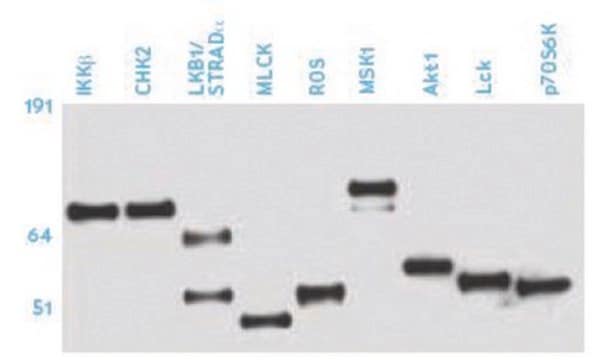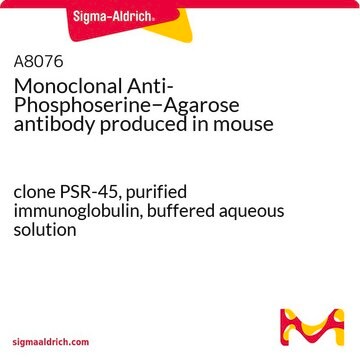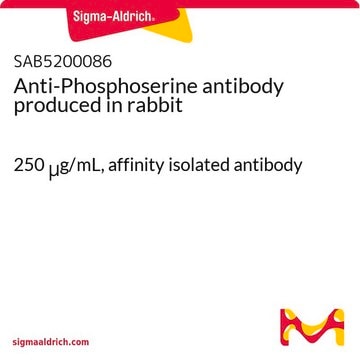P3555
Monoclonal Anti-Phosphothreonine antibody produced in mouse
clone PTR-8, ascites fluid
Sinonimo/i:
Monoclonal Anti-Phosphothreonine, Phospho Thr, Phospho Threonine, Phospho−Thr, Phospho-Threonine, p-Thr
About This Item
Prodotti consigliati
Origine biologica
mouse
Coniugato
unconjugated
Forma dell’anticorpo
ascites fluid
Tipo di anticorpo
primary antibodies
Clone
PTR-8, monoclonal
contiene
15 mM sodium azide
tecniche
indirect ELISA: 1:4,000
western blot: 1:50
Isotipo
IgG2b
Condizioni di spedizione
dry ice
Temperatura di conservazione
−20°C
modifica post-traduzionali bersaglio
unmodified
Cerchi prodotti simili? Visita Guida al confronto tra prodotti
Categorie correlate
Descrizione generale
Immunogeno
Applicazioni
Mouse monoclonal clone PTR-8 anti-phosphothreonine antibody may be used for the localization of phosphorylated threonine using various immunochemical assays such as ELISA, dot blot, and immunoblotting. Due to steric hindrance of the recognition site, this antibody may not recognize certain proteins known to contain phosphorylated threonine.
Azioni biochim/fisiol
Esclusione di responsabilità
Not finding the right product?
Try our Motore di ricerca dei prodotti.
Prodotti correlati
Codice della classe di stoccaggio
10 - Combustible liquids
Classe di pericolosità dell'acqua (WGK)
WGK 3
Punto d’infiammabilità (°F)
Not applicable
Punto d’infiammabilità (°C)
Not applicable
Certificati d'analisi (COA)
Cerca il Certificati d'analisi (COA) digitando il numero di lotto/batch corrispondente. I numeri di lotto o di batch sono stampati sull'etichetta dei prodotti dopo la parola ‘Lotto’ o ‘Batch’.
Possiedi già questo prodotto?
I documenti relativi ai prodotti acquistati recentemente sono disponibili nell’Archivio dei documenti.
I clienti hanno visto anche
Il team dei nostri ricercatori vanta grande esperienza in tutte le aree della ricerca quali Life Science, scienza dei materiali, sintesi chimica, cromatografia, discipline analitiche, ecc..
Contatta l'Assistenza Tecnica.









